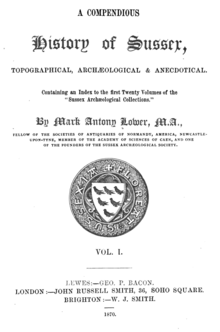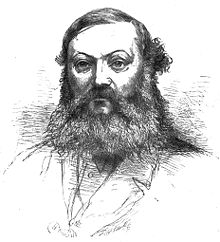- Mark Antony Lower
-
Mark Antony Lower F.S.A. M.A. (1814–1876) was a Sussex historian who founded the Sussex Archaeological Society and is credited with starting the "cult of the Sussex Martyrs",[1] however he was against the excesses of the "Bonfire Boys".[2]
Contents
Life
Lower was born 14 January 1814 to Richard Lower, a schoolmaster, and his wife in Chiddingly. Richard and Mary (née Oxley) gave Lower a good education.[3] It appears he showed an early interest in heraldry as a painted coat of arms in the local church is attributed to him.[4] He worked first at his sister's school in East Hoathly,[5] before further extending the family's interests in local education with a school at Alfriston under his control. Within three years however he left to establish another school in Lewes in Sussex in 1835.
He married Mercy Holman in 1835 when his school had moved to St. Anne's House in Lewes High Street. His establishment of the Sussex Archaeological Society with J.H. Hurdis in 1846 established Lower as a well regarded notable antiquarian. His publication of The Sussex Martyrs, their Examinations and Cruel Burnings in the time of Queen Mary... in 1851 together with an etching by James Henry Hurdis of Richard Woodman and nine other martyrs is credited with establishing the "cult of the Sussex Martyrs".[1] However it is noted that his Sussex Martyrs was really a re-publication of John Foxe's account in his Book of Martyrs.[2] Although Lower is credited with publicising the Sussex Martyrs, he does not appear to have started the Bonfire Societies. His biography credits him with writing a note complaining of the excesses of the "Bonfire Boys", and he had himself been an active member of the Lewes New Temperance Society.[2]
Lower said that he has published the Sussex Martyrs because their deaths had been largely forgotten and high churchmen were referring to the reformation and the deaths of these people as a mistake. Following the publications "anti-popish" demonstrations took place each year around Nov 5th. In 1868 a figure dressed as the "Bishop of Lewes" warned protestants of the Roman catholic threat and the following year an effigy of the pope was to be blown up with gunpowder.[6]
 Title page, A Compendious History of Sussex, Mark Antony Lower, 1870
Title page, A Compendious History of Sussex, Mark Antony Lower, 1870
Lower published numerous articles for the Sussex Archaeological Society and he was employed for a number of years as a secretary. He published a dictionary of British surnames of the United Kingdom in 1860 and The Worthies of Sussex in 1865. Mercy Lower died in 1867. The widower married Sarah Scrase three years later after moving to Seaford. Lower published his important Sussex local history book, A Compendious History of Sussex was completed just a year before he left Lewes for London. He published a guide to Scandinavia in 1874 after touring there to improve his health.[2]
Lower died on 22 March 1876[3] in Enfield. He was buried in St Annes Church in Lewes.[7]
Works
- English surnames, 1842[2]
- The Curiosities of Heraldry[8]
- Chronicles of Pevensey, 1846
- Sussex Archaeological Society, various publications, 1846-
- The Sussex Martyrs, their Examinations and Cruel Burnings in the time of Queen Mary, comprising the interesting personal narrative of Richard Woodman, &c. &c., 1852
- Patronymica Britannica, 1860 (A dictionary of the family names of the United Kingdom)
- The Song of Solomon in the dialect of Sussex; from the authorised English version, 1860
- Parochial history of Chiddingly, 1862[2]
- The Worthies of Sussex, 1865
- A Compendious History of Sussex,1870
- Historical and genealogical notices of the Pelham family, 1873[2]
- The Chronicle of Battel [sic] Abbey, 1851[9]
References
- ^ a b Christopher Whittick, ‘Hurdis, James Henry (1800–1857)’, Oxford Dictionary of National Biography, Oxford University Press, Sept 2004; online edn, Jan 2008 accessed 6 Nov 2009
- ^ a b c d e f g "Mark Antony Lower". Open Library. 2009. http://openlibrary.org/a/OL2029781A/Mark_Antony_Lower. Retrieved 2009-11-08.
- ^ a b Campkin F.S.A., Henry. "Two Sussex archaeologists : William Durrant Cooper and Mark Antony Lower". Bacon. http://en.wikisource.org/wiki/Two_Sussex_archaeologists:_William_Durrant_Cooper_and_Mark_Antony_Lower/Mark_Antony_Lower. Retrieved November 2009.
- ^ Chiddingly Church, Sussex, accessed November 2009
- ^ "Mark Antony Lower". The Weald. http://theweald.org/N10.asp?Nid=1130. Retrieved 2009-11-08.
- ^ Goring, Jeremy (2003). Burn holy fire: religion in Lewes since the Reformation p.129. James Clarke & Co.. pp. 192. ISBN 9780718830403. http://books.google.co.uk/books?id=sNM3339OQPQC&pg=PA136&dq=woodman+richard+martyr&lr=&as_brr=3#v=onepage&q=lower&f=false. Retrieved 10 November 2009.
- ^ John H. Farrant, ‘Lower, Mark Antony (1813–1876)’, Oxford Dictionary of National Biography, Oxford University Press, 2004 accessed 8 Nov 2009
- ^ The Curiosities of Heraldry, 1844, Google books, accessed November 2009
- ^ The Chronicle of Battel Abbey, 1066 to 1176, Mark Antony Lower, John Russell Smith, London, 1851
Further reading
- Patronymica Britannica: A Dictionary of the Family Names of the United Kingdom, Mark Antony Lower, Published by John Russell Smith, London, 1860
- The Chronicle of Battel Abbey, from 1066 to 1176, Mark Antony Lower, Printed by John Russell Smith, London, 1851
- A Compendious History of Sussex, Topographical, Archaeological & Anecdotal, Mark Antony Lower, Published by George P. Bacon, Lewes, 1870
- English Surnames: An Essay on Family Nomenclature, Historical, Etymological and Humorous, Mark Antony Lower, Published by John Russell Smith, London, 1875
Categories:- English antiquarians
- People from Sussex
- Archaeological writers
- 1814 births
- 1876 deaths
- British historians
Wikimedia Foundation. 2010.


